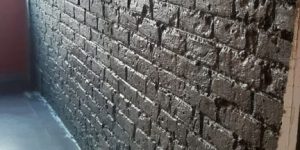WATERPROOFING

Waterproofing is the process of making an object or structure waterproof or water-resistant so that it remains relatively unaffected by water or resisting the ingress of water under specified conditions. It helps reduce humidity inside the house and thereby protects things inside your house from damage caused due to humidity or water exposure. It is also important for the veracity of the building.
Places of Application:
- Basement of the building
- Kitchen, Toilet and Bathroom
- Balcony areas
- Roof /Terrace
- Swimming Pool
- Water Tank
Cementitious Waterproofing
Cementitious products are probably the easiest waterproofing materials to use. They’re readily available from suppliers of masonry products, and they’re easy to mix and apply. If you plan to use this material, a long-handled brush will make your life easier. Also, spend the extra money to buy acrylic additives (a white, milky liquid) to mix in with the cement product. You’ll get better bonding and a more solid, durable coating.
Cementitious waterproofing is used in the following type of structures:
- Water Treatment Plants
- Sewage Treatment Plants
- Bridges
- Dams
- Railway & Subway Systems
- Marine Cargo Ports & Docks
- River Locks/Channels & Concrete Dykes
- Parking Structures & Lots
- Tunnels
Liquid waterproofing membrane
Liquid Roofing is the process of waterproofing a roof by the application of a specialist liquid roof coating. It is suited to all types of roof, including flat, pitched, and domed. Liquid roofing involves the application of a monolithic, fully bonded, liquid based coating to a roof. The coating cures to form a rubber-like elastomeric waterproof membrane, capable of stretching and returning to its original shape without damage. Such coating systems are usually reinforced with secondary materials such as glass-reinforced plastic to provide additional tensile strength. The coatings can be applied over most traditional roofing materials, including felt, asphalt, bitumen, and concrete.
The process of liquid roofing provides a cost-effective method of making a new or existing roof waterproof. It can deliver up to 25 years of performance depending on the coating system employed. It is estimated that liquid roofing is 70% less expensive than overall roof replacement in refurbishment situations.
Bituminous waterproofing
Bituminous waterproofing systems are designed to protect residential and commercial buildings. Bitumen (asphalt or coal-tar pitch) is a mixed substance made up of organic liquids that are highly sticky, viscous, and waterproof. These systems are sometimes used to construct roofs, in the form of roofing felt or roll roofing products.
Bituminous Coating Waterproofing Method
Bituminous coating is a type of coating used for waterproofing and flexible protective coating. It is an excellent protective coating and waterproofing agent, especially on surfaces such as concrete foundations.
Bituminous Membrane Waterproofing Method
Bituminous membrane waterproofing is a popular method used for low-sloped roofs due to their proven performance.
Polyurethane Waterproofing
Polyurethane is made up of two components, base and reactor. Polyol acts as the base, while isocyanide is the reactor component. The combination of both these in a specific design ratio creates a liquid coating for waterproofing applications. Polyurethane is a rather popular choice due to its ease of installation. Unlike other waterproofing systems like sheet membranes and liquid applied membranes, this polyurethane application requires comparatively less skill and supervision. Application is fast and this type of treatment can be used for post construction applications as well.
It is easy to install, provides seamless finish and has a long term durability and wear resistance. It is UV and weather resistant alkaline cleaners, battery acid and fuels.
